roof TOYOTA AURIS HYBRID 2013 Owners Manual
[x] Cancel search | Manufacturer: TOYOTA, Model Year: 2013, Model line: AURIS HYBRID, Model: TOYOTA AURIS HYBRID 2013Pages: 768, PDF Size: 21.22 MB
Page 4 of 768
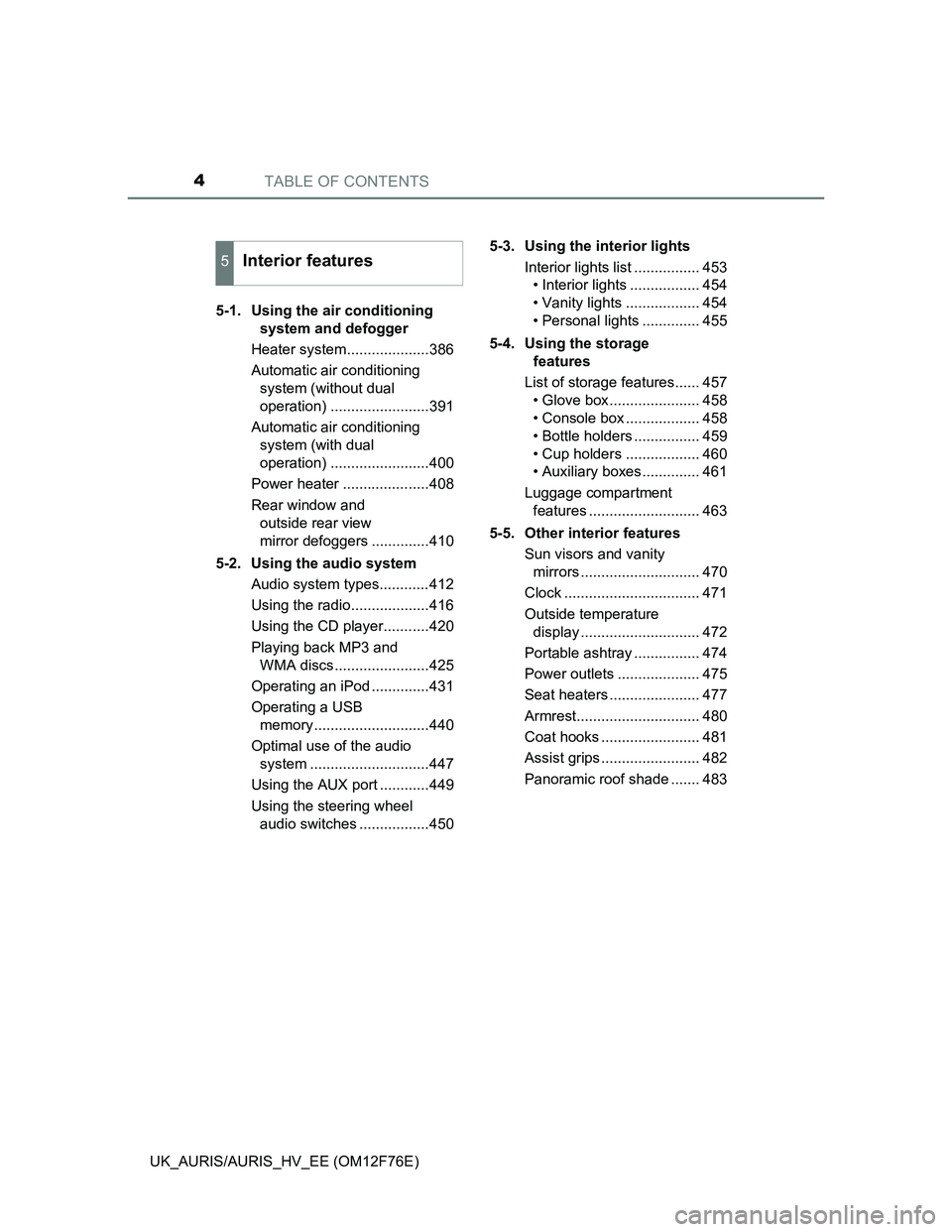
TABLE OF CONTENTS4
UK_AURIS/AURIS_HV_EE (OM12F76E)5-1. Using the air conditioning
system and defogger
Heater system....................386
Automatic air conditioning
system (without dual
operation) ........................391
Automatic air conditioning
system (with dual
operation) ........................400
Power heater .....................408
Rear window and
outside rear view
mirror defoggers ..............410
5-2. Using the audio system
Audio system types............412
Using the radio...................416
Using the CD player...........420
Playing back MP3 and
WMA discs.......................425
Operating an iPod ..............431
Operating a USB
memory............................440
Optimal use of the audio
system .............................447
Using the AUX port ............449
Using the steering wheel
audio switches .................4505-3. Using the interior lights
Interior lights list ................ 453
• Interior lights ................. 454
• Vanity lights .................. 454
• Personal lights .............. 455
5-4. Using the storage
features
List of storage features...... 457
• Glove box...................... 458
• Console box .................. 458
• Bottle holders ................ 459
• Cup holders .................. 460
• Auxiliary boxes .............. 461
Luggage compartment
features ........................... 463
5-5. Other interior features
Sun visors and vanity
mirrors ............................. 470
Clock ................................. 471
Outside temperature
display ............................. 472
Portable ashtray ................ 474
Power outlets .................... 475
Seat heaters ...................... 477
Armrest.............................. 480
Coat hooks ........................ 481
Assist grips ........................ 482
Panoramic roof shade ....... 483
5Interior features
Page 25 of 768

25Pictorial index
UK_AURIS/AURIS_HV_EE (OM12F76E)Inside rear view mirror . . . . . . . . . . . . . . . . . . . . . . . . . . . . . P. 214
Sun visors
*1. . . . . . . . . . . . . . . . . . . . . . . . . . . . . . . . . . . . . . P. 470
Vanity mirrors . . . . . . . . . . . . . . . . . . . . . . . . . . . . . . . . . . . . P. 470
Vanity lights
*2 . . . . . . . . . . . . . . . . . . . . . . . . . . . . . . . . . . . . P. 454
Interior lights/personal lights . . . . . . . . . . . . . . . . . . . . P. 454, 455
Panoramic roof shade switch
*2. . . . . . . . . . . . . . . . . . . . . . P. 483
Auxiliary boxes . . . . . . . . . . . . . . . . . . . . . . . . . . . . . . . . . . . P. 461
Microphone
*2, 3
Assist grips . . . . . . . . . . . . . . . . . . . . . . . . . . . . . . . . . . . . . . P. 482
1
2
3
4
5
6
7
8
9
*1: NEVER use a rearward facing child
restraint on a seat protected by an
ACTIVE AIRBAG in front of it, DEATH
or SERIOUS INJURY to the CHILD
can occur. (P. 7 6 )
*2: If equipped
*3: Refer to ““touch screen” Owner’s manual”.
Page 35 of 768

35Pictorial index
UK_AURIS/AURIS_HV_EE (OM12F76E)Inside rear view mirror . . . . . . . . . . . . . . . . . . . . . . . . . . . . . P. 214
Sun visors
*1. . . . . . . . . . . . . . . . . . . . . . . . . . . . . . . . . . . . . . P. 470
Vanity mirrors . . . . . . . . . . . . . . . . . . . . . . . . . . . . . . . . . . . . P. 470
Vanity lights
*2 . . . . . . . . . . . . . . . . . . . . . . . . . . . . . . . . . . . . P. 454
Interior lights/personal lights . . . . . . . . . . . . . . . . . . . . P. 454, 455
Panoramic roof shade switch
*2. . . . . . . . . . . . . . . . . . . . . . P. 483
Auxiliary boxes
*2 . . . . . . . . . . . . . . . . . . . . . . . . . . . . . . . . . P. 461
Microphone
*2, 3
Assist grips . . . . . . . . . . . . . . . . . . . . . . . . . . . . . . . . . . . . . . P. 482
1
2
3
4
5
6
7
8
9
*1: NEVER use a rearward facing child
restraint on a seat protected by an
ACTIVE AIRBAG in front of it, DEATH
or SERIOUS INJURY to the CHILD
can occur. (P. 7 6 )
*2: If equipped
*3: Refer to ““touch screen” Owner’s manual”.
Page 49 of 768
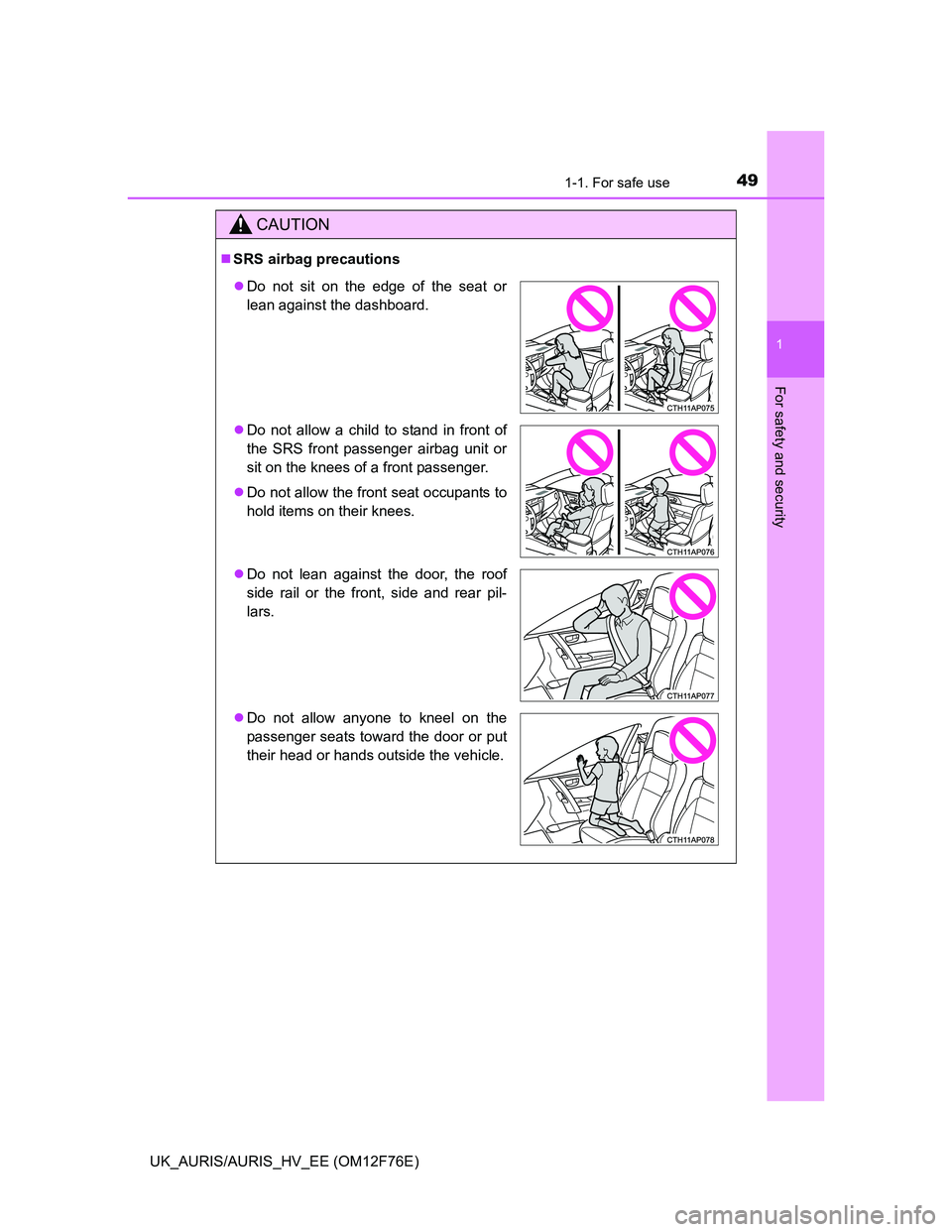
491-1. For safe use
1
For safety and security
UK_AURIS/AURIS_HV_EE (OM12F76E)
CAUTION
SRS airbag precautions
Do not sit on the edge of the seat or
lean against the dashboard.
Do not allow a child to stand in front of
the SRS front passenger airbag unit or
sit on the knees of a front passenger.
Do not allow the front seat occupants to
hold items on their knees.
Do not lean against the door, the roof
side rail or the front, side and rear pil-
lars.
Do not allow anyone to kneel on the
passenger seats toward the door or put
their head or hands outside the vehicle.
Page 50 of 768
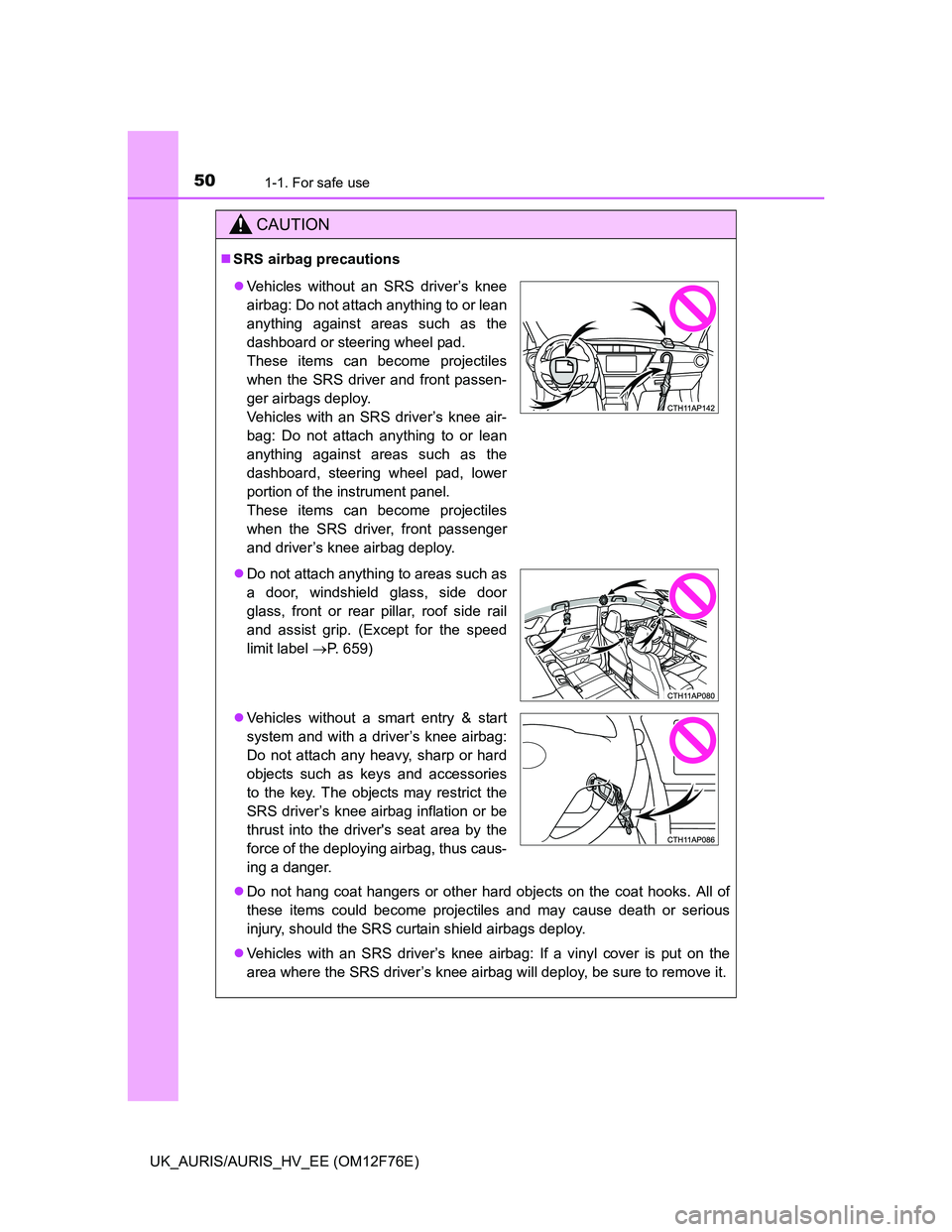
501-1. For safe use
UK_AURIS/AURIS_HV_EE (OM12F76E)
CAUTION
SRS airbag precautions
Do not hang coat hangers or other hard objects on the coat hooks. All of
these items could become projectiles and may cause death or serious
injury, should the SRS curtain shield airbags deploy.
Vehicles with an SRS driver’s knee airbag: If a vinyl cover is put on the
area where the SRS driver’s knee airbag will deploy, be sure to remove it.
Vehicles without an SRS driver’s knee
airbag: Do not attach anything to or lean
anything against areas such as the
dashboard or steering wheel pad.
These items can become projectiles
when the SRS driver and front passen-
ger airbags deploy.
Vehicles with an SRS driver’s knee air-
bag: Do not attach anything to or lean
anything against areas such as the
dashboard, steering wheel pad, lower
portion of the instrument panel.
These items can become projectiles
when the SRS driver, front passenger
and driver’s knee airbag deploy.
Do not attach anything to areas such as
a door, windshield glass, side door
glass, front or rear pillar, roof side rail
and assist grip. (Except for the speed
limit label P. 6 5 9 )
Vehicles without a smart entry & start
system and with a driver’s knee airbag:
Do not attach any heavy, sharp or hard
objects such as keys and accessories
to the key. The objects may restrict the
SRS driver’s knee airbag inflation or be
thrust into the driver's seat area by the
force of the deploying airbag, thus caus-
ing a danger.
Page 51 of 768
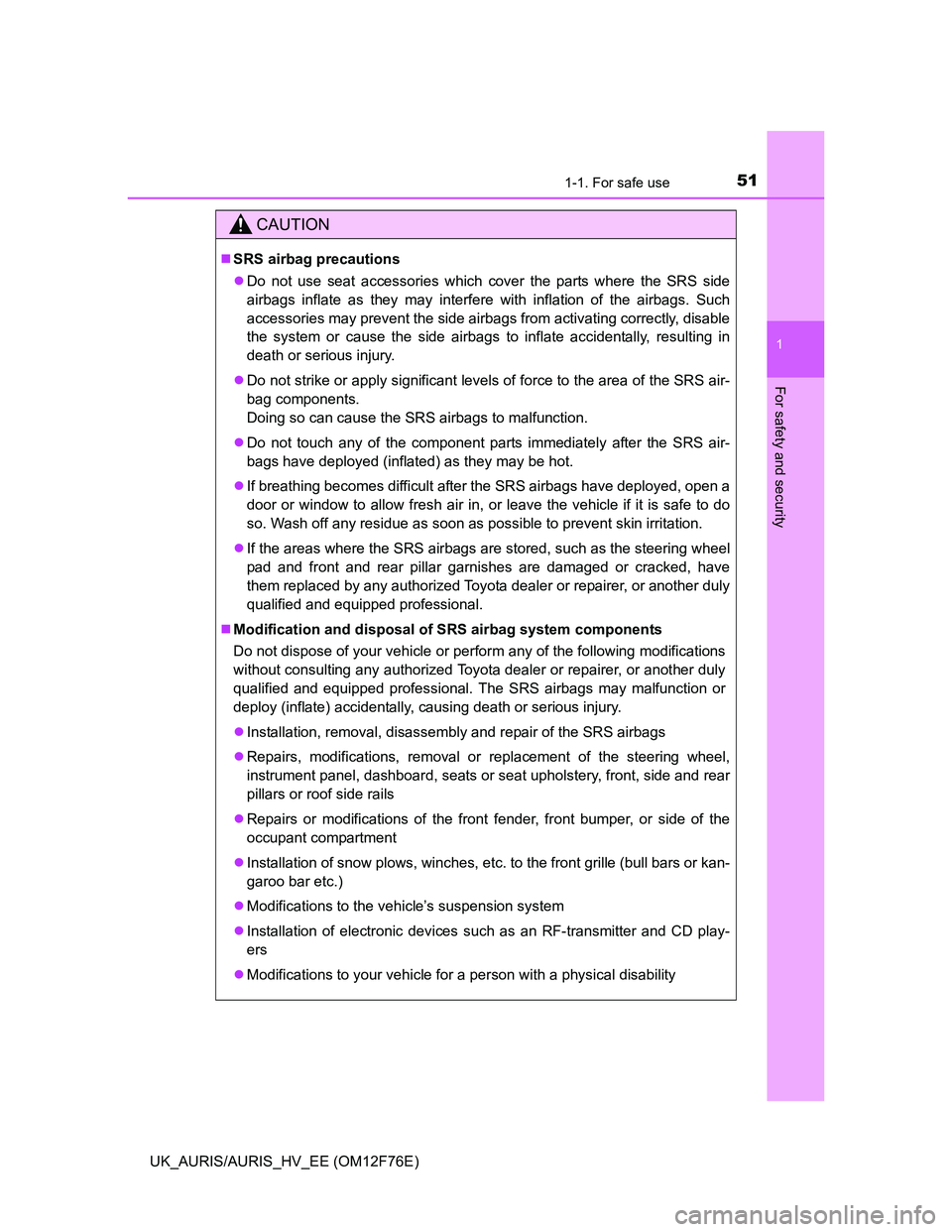
511-1. For safe use
1
For safety and security
UK_AURIS/AURIS_HV_EE (OM12F76E)
CAUTION
SRS airbag precautions
Do not use seat accessories which cover the parts where the SRS side
airbags inflate as they may interfere with inflation of the airbags. Such
accessories may prevent the side airbags from activating correctly, disable
the system or cause the side airbags to inflate accidentally, resulting in
death or serious injury.
Do not strike or apply significant levels of force to the area of the SRS air-
bag components.
Doing so can cause the SRS airbags to malfunction.
Do not touch any of the component parts immediately after the SRS air-
bags have deployed (inflated) as they may be hot.
If breathing becomes difficult after the SRS airbags have deployed, open a
door or window to allow fresh air in, or leave the vehicle if it is safe to do
so. Wash off any residue as soon as possible to prevent skin irritation.
If the areas where the SRS airbags are stored, such as the steering wheel
pad and front and rear pillar garnishes are damaged or cracked, have
them replaced by any authorized Toyota dealer or repairer, or another duly
qualified and equipped professional.
Modification and disposal of SRS airbag system components
Do not dispose of your vehicle or perform any of the following modifications
without consulting any authorized Toyota dealer or repairer, or another duly
qualified and equipped professional. The SRS airbags may malfunction or
deploy (inflate) accidentally, causing death or serious injury.
Installation, removal, disassembly and repair of the SRS airbags
Repairs, modifications, removal or replacement of the steering wheel,
instrument panel, dashboard, seats or seat upholstery, front, side and rear
pillars or roof side rails
Repairs or modifications of the front fender, front bumper, or side of the
occupant compartment
Installation of snow plows, winches, etc. to the front grille (bull bars or kan-
garoo bar etc.)
Modifications to the vehicle’s suspension system
Installation of electronic devices such as an RF-transmitter and CD play-
ers
Modifications to your vehicle for a person with a physical disability
Page 52 of 768
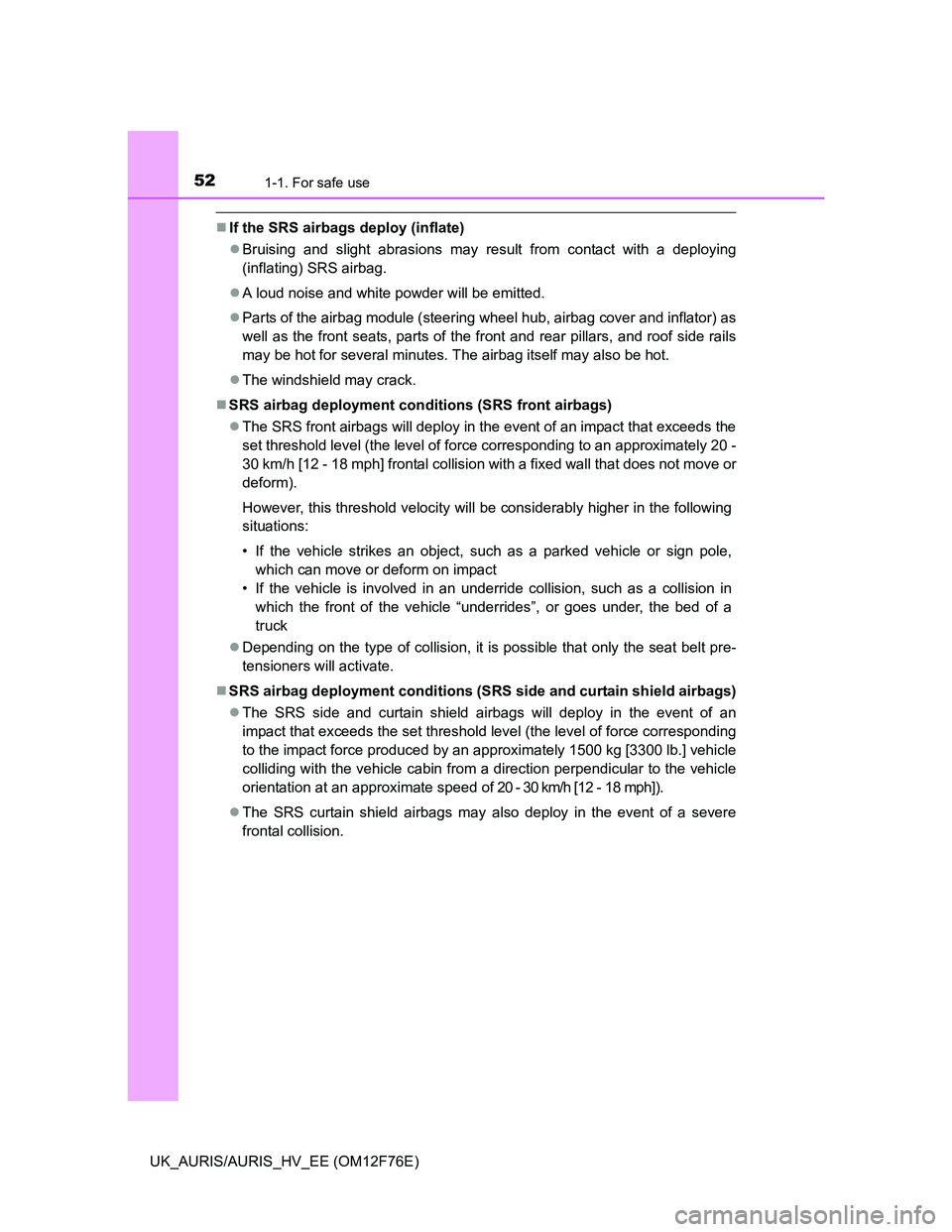
521-1. For safe use
UK_AURIS/AURIS_HV_EE (OM12F76E)
If the SRS airbags deploy (inflate)
Bruising and slight abrasions may result from contact with a deploying
(inflating) SRS airbag.
A loud noise and white powder will be emitted.
Parts of the airbag module (steering wheel hub, airbag cover and inflator) as
well as the front seats, parts of the front and rear pillars, and roof side rails
may be hot for several minutes. The airbag itself may also be hot.
The windshield may crack.
SRS airbag deployment conditions (SRS front airbags)
The SRS front airbags will deploy in the event of an impact that exceeds the
set threshold level (the level of force corresponding to an approximately 20 -
30 km/h [12 - 18 mph] frontal collision with a fixed wall that does not move or
deform).
However, this threshold velocity will be considerably higher in the following
situations:
• If the vehicle strikes an object, such as a parked vehicle or sign pole,
which can move or deform on impact
• If the vehicle is involved in an underride collision, such as a collision in
which the front of the vehicle “underrides”, or goes under, the bed of a
truck
Depending on the type of collision, it is possible that only the seat belt pre-
tensioners will activate.
SRS airbag deployment conditions (SRS side and curtain shield airbags)
The SRS side and curtain shield airbags will deploy in the event of an
impact that exceeds the set threshold level (the level of force corresponding
to the impact force produced by an approximately 1500 kg [3300 lb.] vehicle
colliding with the vehicle cabin from a direction perpendicular to the vehicle
orientation at an approximate speed of 20 - 30 km/h [12 - 18 mph]).
The SRS curtain shield airbags may also deploy in the event of a severe
frontal collision.
Page 55 of 768
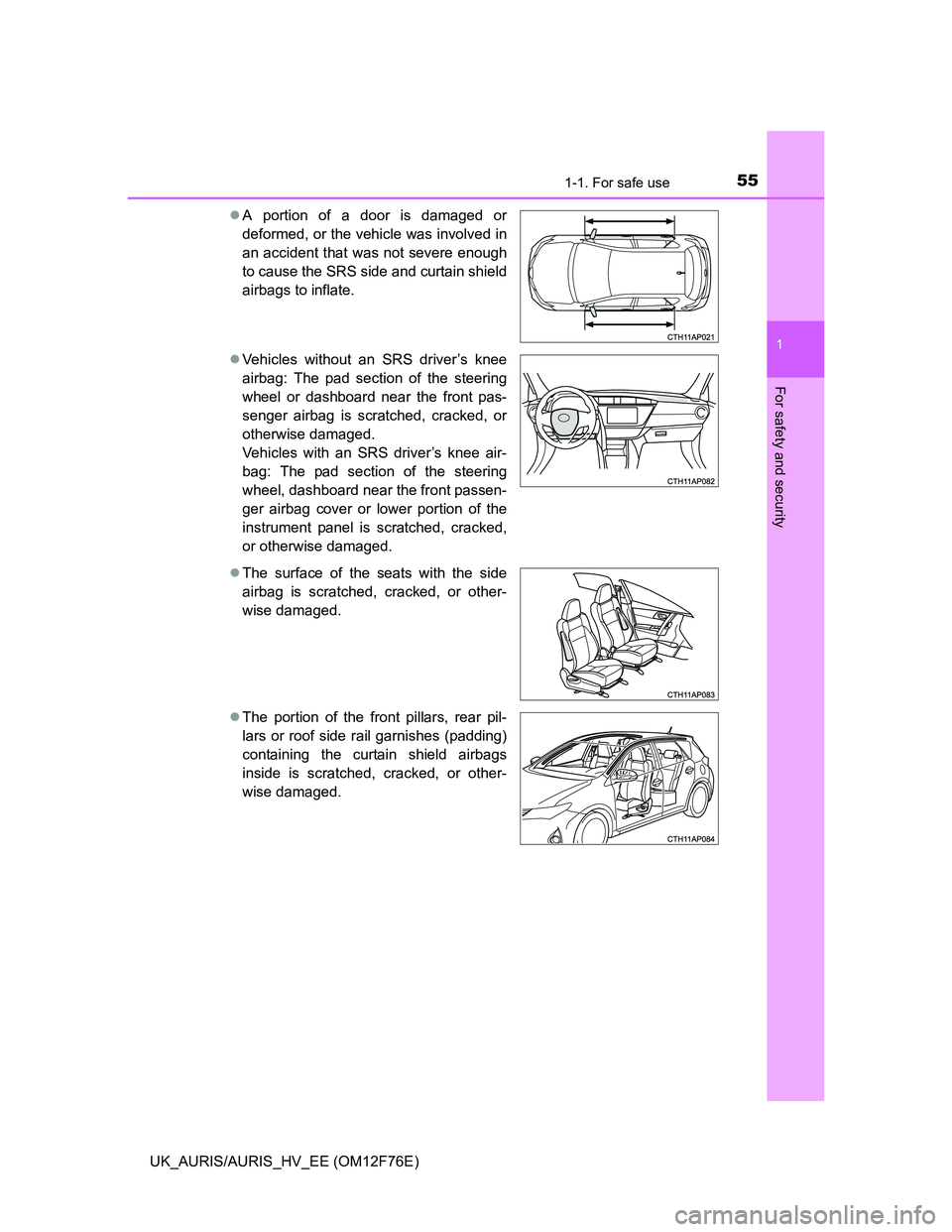
551-1. For safe use
1
For safety and security
UK_AURIS/AURIS_HV_EE (OM12F76E)A portion of a door is damaged or
deformed, or the vehicle was involved in
an accident that was not severe enough
to cause the SRS side and curtain shield
airbags to inflate.
Vehicles without an SRS driver’s knee
airbag: The pad section of the steering
wheel or dashboard near the front pas-
senger airbag is scratched, cracked, or
otherwise damaged.
Vehicles with an SRS driver’s knee air-
bag: The pad section of the steering
wheel, dashboard near the front passen-
ger airbag cover or lower portion of the
instrument panel is scratched, cracked,
or otherwise damaged.
The surface of the seats with the side
airbag is scratched, cracked, or other-
wise damaged.
The portion of the front pillars, rear pil-
lars or roof side rail garnishes (padding)
containing the curtain shield airbags
inside is scratched, cracked, or other-
wise damaged.
Page 66 of 768
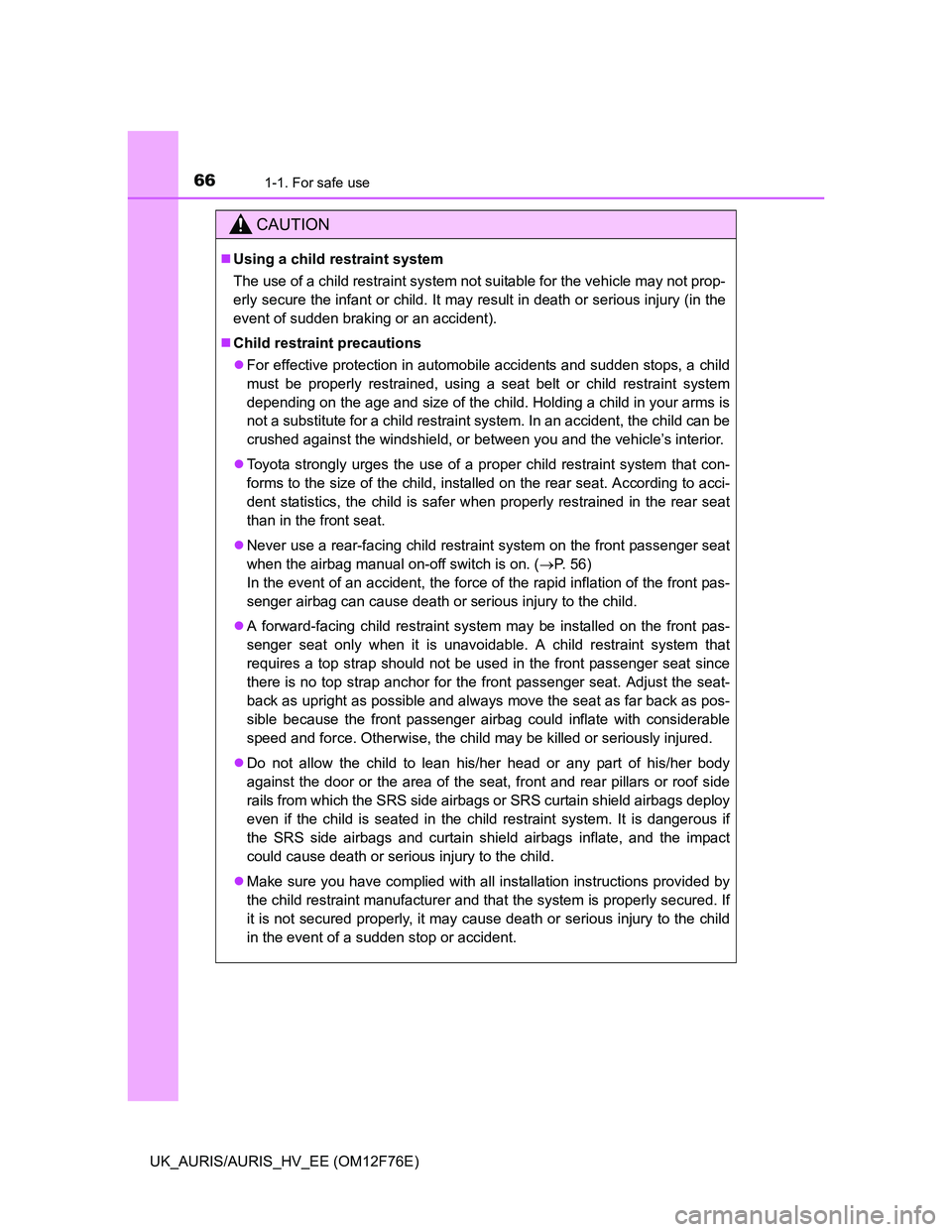
661-1. For safe use
UK_AURIS/AURIS_HV_EE (OM12F76E)
CAUTION
Using a child restraint system
The use of a child restraint system not suitable for the vehicle may not prop-
erly secure the infant or child. It may result in death or serious injury (in the
event of sudden braking or an accident).
Child restraint precautions
For effective protection in automobile accidents and sudden stops, a child
must be properly restrained, using a seat belt or child restraint system
depending on the age and size of the child. Holding a child in your arms is
not a substitute for a child restraint system. In an accident, the child can be
crushed against the windshield, or between you and the vehicle’s interior.
Toyota strongly urges the use of a proper child restraint system that con-
forms to the size of the child, installed on the rear seat. According to acci-
dent statistics, the child is safer when properly restrained in the rear seat
than in the front seat.
Never use a rear-facing child restraint system on the front passenger seat
when the airbag manual on-off switch is on. (P. 56)
In the event of an accident, the force of the rapid inflation of the front pas-
senger airbag can cause death or serious injury to the child.
A forward-facing child restraint system may be installed on the front pas-
senger seat only when it is unavoidable. A child restraint system that
requires a top strap should not be used in the front passenger seat since
there is no top strap anchor for the front passenger seat. Adjust the seat-
back as upright as possible and always move the seat as far back as pos-
sible because the front passenger airbag could inflate with considerable
speed and force. Otherwise, the child may be killed or seriously injured.
Do not allow the child to lean his/her head or any part of his/her body
against the door or the area of the seat, front and rear pillars or roof side
rails from which the SRS side airbags or SRS curtain shield airbags deploy
even if the child is seated in the child restraint system. It is dangerous if
the SRS side airbags and curtain shield airbags inflate, and the impact
could cause death or serious injury to the child.
Make sure you have complied with all installation instructions provided by
the child restraint manufacturer and that the system is properly secured. If
it is not secured properly, it may cause death or serious injury to the child
in the event of a sudden stop or accident.
Page 379 of 768

3794-6. Driving tips
UK_AURIS/AURIS_HV_EE (OM12F76E)
4
Driving
Air conditioning
Use the air conditioning only when necessary. Doing so can help
control excessive gasoline consumption.
In summer: In high temperatures, use the recirculated air mode.
Doing so will help to reduce the burden on the air conditioner and
reduce fuel consumption as well.
In winter: Because the gasoline engine will not automatically cut out
until the gasoline engine and the interior of the vehicle are warm, it
will consume fuel. Also, fuel consumption can be improved by
avoiding overuse of the heater.
Checking tire inflation pressure
Make sure to check the tire inflation pressure frequently. Improper
tire inflation pressure can cause poor fuel consumption.
Also, as snow tires can cause large amounts of friction, their use on
dry roads can lead to poor fuel consumption. Use a tire that is
appropriate for the season.
Luggage
Carrying heavy luggage can lead to poor fuel consumption. Avoid
carrying unnecessary luggage. Installing a large roof rack can also
cause poor fuel consumption.
Warming up before driving
Since the gasoline engine starts up and cuts out automatically
when cold, warming up the engine is unnecessary. Moreover, fre-
quently driving short distances will cause the engine to repeatedly
warm up, which can lead to poor fuel consumption.